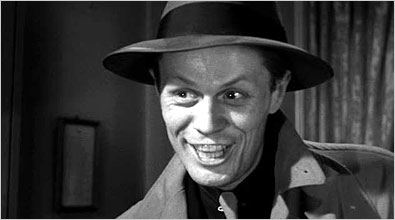
In the classic 1947 film noir Kiss of Death, Victor Mature plays an Nick Bianco, an ex-con with horrific luck. He gets caught on a heist and takes the rap for his cohorts; this leads to a long sentence and a double-cross with impacts to his wife and kids. Seeking to see his kids again, he is released back on the streets to set up the double-crossers for the DA (Brian Donlevy).
Bianco keeps getting trapped – by the cops, by the mob, but mostly by his own code of never squealing to the authorities. When he finally changes his moral course in the interest of his family, his resolutely bad luck puts them in even more danger. Bianco must race against time to save them and find his own redemption.,
Mature, too often dismissed for his campy sword-and-sandal movies, did his finest work in film noir – especially I Wake Up Screaming, Kiss of Death and The Long Haul. He is wonderfully appealing here, and is believable both as the close-mouthed professional hood and as the sentimental family guy.

Kiss of Death is justifiably most remembered today for Richard Widmark’s breakthrough performance as psychopath Tommy Udo, who chortles maniacally as he pushes an old lady in a wheelchair down the stairs to her demise. Not only was this Widmark’s first screen role, the wheelchair-down-the-stairs scene was the first scene he ever filmed. Widmark’s performance here is so much more than that one scene – no one had even seen a giggling psycho character like his Tommy Udo before. Widmark went on to play indelible neurotics and sleazes in noir for the next three years (Roadhouse, Panic in the Streets, Night and the City, No Way Out, Pickup on South Street) before becoming an A-lister.
Brian Donlevy is really compelling here as Assistant DA Louis D’Angelo. Donlevy could play characters who ranged from tough to brutal, but his film noir roles were guyswhowere manipulated (The Glass Key) or abused (The Big Combo). Not so in Kiss of Death, where he plays a guy with balls, who is also fundamentally decent and empathetic. Those qualities don’t keep D’Angelo, ever aware of his leverage, from being unyielding in his use of the awful power of the state.
Coleen Gray was a bigger star in the late 40s than we remember today; her first three starring roles were Kiss of Death, Nightmare Alley and Red River. Even in the very noir Kiss of Death, she played the perky Good Girl.

Prolific character actor Taylor Holmes is excellent as Earl Howser, the grinning and profoundly insincere mob lawyer. I don’t remember many of Holmes’ 106 screen appearances, but he had a nice run in late 1940s noir, playing an even more venal lawyer (a disbarred one) in Act of Violence and the gullible tycoon in Nightmare Alley.
Veteran director Henry Hathaway opens and closes the film with bookend ticking time bomb scenes. First, after after a robbery on the 23rd floor, Mature and cronies attempt their getaway down a crowded elevator, sweating it out as the doors open and close on seemingly every floor. At the end, Mature gives the cops a two minute countdown that has life-and-death stakes.
The source material was a treatment (later refined into a novel) by real-life prosecutor Eleazar Lipsky. The screenplay was written by the top-tier Ben Hecht and Charles Lederer. Modern viewers will find a nun-run orphanage oddly benign (and the acerbic Hecht must have gagged while penning it).
Kiss of Death was shot by twice Oscar-nominated cinematographer Norbert Brodine, who knew his way around noir lighting (Boomerang!, Road House, Thieves Highway).
Kiss of Death is hard to find on streaming platforms, but it plays often on Turner Classic Movies. I’ve seen it again in 35mm at the 2025 Noir City. Don’t confuse this 1947 classic with the many inferior films with the same title.

